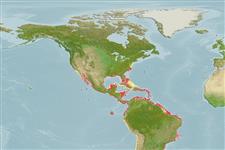>
Eupercaria/misc (Various families in series Eupercaria) >
Gerreidae (Mojarras)
Etymology: Eucinostomus: Greek, eu = good + Greek, kyon = dog + Greek, stoma = mouth (Ref. 45335).
More on authors: Baird & Girard.
Environment: milieu / climate zone / depth range / distribution range
Ekologi
marina; sötvatten; brackvatten revassocierade; djupintervall 0 - 12 m (Ref. 5227). Subtropical; 41°N - 30°S, 120°W - 34°W
Eastern Pacific: Anaheim Bay in southern California, USA southward to Peru, including the Galapagos Islands. Western Atlantic: New Jersey, USA and Bermuda through the Gulf of Mexico and the Caribbean to southeastern Brazil (Ref. 7251).
Length at first maturity / Size / Vikt / Age
Maturity: Lm 12.8 range ? - ? cm
Max length : 21.2 cm TL hane/ej könsbestämd; (Ref. 102462); common length : 15.0 cm TL hane/ej könsbestämd; (Ref. 3722); publicerad maxvikt: 119.66 g (Ref. 102462)
Taggstrålar i ryggfenan (totalt) : 9; Mjukstrålar i ryggfenan (totalt) : 10; Taggstrålar i analfenan: 3; Mjukstrålar i analfenan: 8. Tip of dorsal fin dusky. Premaxillary groove continuous but narrow, bordered by scales anteriorly (Ref. 26938).
Found over soft bottoms of bays and shallow inshore areas, often along sand beaches (Ref. 2850). Enters freshwater (Ref. 7251). Juveniles are encountered in lagoons of mangroves. Omnivorous (Ref. 9303). Marketed fresh but not highly esteemed; processed into fish meal and used as live bait in the snapper fishery (Ref. 3722).
Life cycle and mating behavior
Könsmognad | Reproduktion | Lek | Ägg | Fecundity | Larver
Eschmeyer, W.N., E.S. Herald and H. Hammann, 1983. A field guide to Pacific coast fishes of North America. Boston (MA, USA): Houghton Mifflin Company. xii+336 p. (Ref. 2850)
IUCN Red List Status (Ref. 130435: Version 2024-2)
Threat to humans
Harmless
Human uses
Fiskeri: mindre kommeriell; bete: occasionally
Verktyg
Special reports
Download XML
Internet-källor
Estimates based on models
Preferred temperature (Ref.
123201): 20.6 - 28.3, mean 27 °C (based on 1053 cells).
Phylogenetic diversity index (Ref.
82804): PD
50 = 0.5010 [Uniqueness, from 0.5 = low to 2.0 = high].
Bayesian length-weight: a=0.01000 (0.00845 - 0.01183), b=3.08 (3.04 - 3.12), in cm total length, based on LWR estimates for this species (Ref.
93245).
Trofisk nivå (Ref.
69278): 3.2 ±0.1 se; based on diet studies.
Resiliens (Ref.
120179): Hög, lägsta populationsfördubblingstid mindre än 15 månader (Preliminary K or Fecundity.).
Fishing Vulnerability (Ref.
59153): Low to moderate vulnerability (25 of 100).
Nutrients (Ref.
124155): Calcium = 51.4 [19.0, 111.5] mg/100g; Iron = 0.642 [0.289, 1.253] mg/100g; Protein = 20.1 [18.1, 22.1] %; Omega3 = 0.216 [0.105, 0.433] g/100g; Selenium = 9.44 [4.21, 20.40] μg/100g; VitaminA = 54.2 [13.4, 206.5] μg/100g; Zinc = 1.2 [0.7, 1.9] mg/100g (wet weight);
